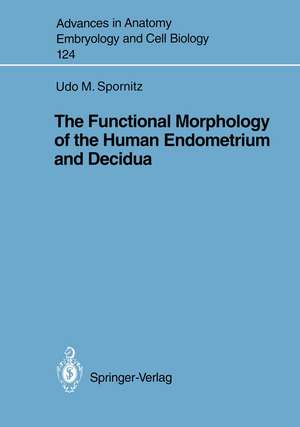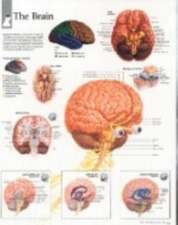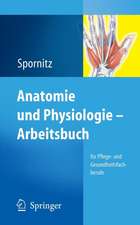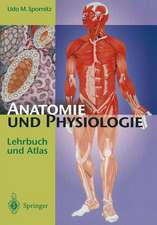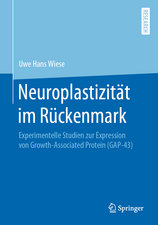The Functional Morphology of the Human Endometrium and Decidua: Advances in Anatomy, Embryology and Cell Biology, cartea 124
Autor Udo M. Spornitzen Limba Engleză Paperback – 31 ian 1992
Din seria Advances in Anatomy, Embryology and Cell Biology
- 5%
 Preț: 1146.33 lei
Preț: 1146.33 lei - 5%
 Preț: 721.19 lei
Preț: 721.19 lei - 15%
 Preț: 637.13 lei
Preț: 637.13 lei -
 Preț: 381.81 lei
Preț: 381.81 lei - 15%
 Preț: 644.95 lei
Preț: 644.95 lei - 5%
 Preț: 1025.16 lei
Preț: 1025.16 lei - 15%
 Preț: 689.97 lei
Preț: 689.97 lei - 15%
 Preț: 577.07 lei
Preț: 577.07 lei - 15%
 Preț: 580.36 lei
Preț: 580.36 lei - 5%
 Preț: 393.51 lei
Preț: 393.51 lei -
 Preț: 408.66 lei
Preț: 408.66 lei -
![Die Schlüpfdrüse der Geburtshelferkröte (Alytes o. obstetricans [LAURENTI]) und anderer Froschlurche](https://i4.books-express.ro/bs/9783662239742/die-schluepfdruese-der-geburtshelferkroete-alytes-o-obstetricans-laurenti-und-anderer-froschlurche.jpg) Preț: 408.27 lei
Preț: 408.27 lei - 5%
 Preț: 1090.61 lei
Preț: 1090.61 lei - 5%
 Preț: 705.11 lei
Preț: 705.11 lei - 5%
 Preț: 706.04 lei
Preț: 706.04 lei - 5%
 Preț: 357.61 lei
Preț: 357.61 lei - 5%
 Preț: 704.59 lei
Preț: 704.59 lei - 5%
 Preț: 705.11 lei
Preț: 705.11 lei - 5%
 Preț: 359.42 lei
Preț: 359.42 lei - 5%
 Preț: 711.52 lei
Preț: 711.52 lei - 15%
 Preț: 635.47 lei
Preț: 635.47 lei - 15%
 Preț: 631.72 lei
Preț: 631.72 lei - 15%
 Preț: 633.35 lei
Preț: 633.35 lei - 15%
 Preț: 632.37 lei
Preț: 632.37 lei - 5%
 Preț: 706.60 lei
Preț: 706.60 lei - 15%
 Preț: 631.07 lei
Preț: 631.07 lei - 5%
 Preț: 707.13 lei
Preț: 707.13 lei - 5%
 Preț: 707.33 lei
Preț: 707.33 lei - 5%
 Preț: 359.60 lei
Preț: 359.60 lei - 5%
 Preț: 707.69 lei
Preț: 707.69 lei - 5%
 Preț: 707.13 lei
Preț: 707.13 lei - 5%
 Preț: 708.06 lei
Preț: 708.06 lei - 5%
 Preț: 706.41 lei
Preț: 706.41 lei - 5%
 Preț: 708.78 lei
Preț: 708.78 lei - 5%
 Preț: 705.68 lei
Preț: 705.68 lei - 5%
 Preț: 705.11 lei
Preț: 705.11 lei - 15%
 Preț: 635.15 lei
Preț: 635.15 lei - 15%
 Preț: 631.07 lei
Preț: 631.07 lei - 5%
 Preț: 706.77 lei
Preț: 706.77 lei - 5%
 Preț: 706.04 lei
Preț: 706.04 lei - 5%
 Preț: 710.79 lei
Preț: 710.79 lei - 5%
 Preț: 705.32 lei
Preț: 705.32 lei - 15%
 Preț: 633.19 lei
Preț: 633.19 lei - 15%
 Preț: 629.09 lei
Preț: 629.09 lei - 15%
 Preț: 633.53 lei
Preț: 633.53 lei - 15%
 Preț: 632.70 lei
Preț: 632.70 lei - 15%
 Preț: 633.68 lei
Preț: 633.68 lei - 18%
 Preț: 773.72 lei
Preț: 773.72 lei - 15%
 Preț: 630.43 lei
Preț: 630.43 lei
Preț: 706.77 lei
Preț vechi: 743.97 lei
-5% Nou
Puncte Express: 1060
Preț estimativ în valută:
135.24€ • 141.20$ • 111.93£
135.24€ • 141.20$ • 111.93£
Carte tipărită la comandă
Livrare economică 05-19 aprilie
Preluare comenzi: 021 569.72.76
Specificații
ISBN-13: 9783540545194
ISBN-10: 3540545190
Pagini: 112
Ilustrații: VII, 99 p. 39 illus.
Dimensiuni: 170 x 242 x 6 mm
Greutate: 0.2 kg
Ediția:1992
Editura: Springer Berlin, Heidelberg
Colecția Springer
Seria Advances in Anatomy, Embryology and Cell Biology
Locul publicării:Berlin, Heidelberg, Germany
ISBN-10: 3540545190
Pagini: 112
Ilustrații: VII, 99 p. 39 illus.
Dimensiuni: 170 x 242 x 6 mm
Greutate: 0.2 kg
Ediția:1992
Editura: Springer Berlin, Heidelberg
Colecția Springer
Seria Advances in Anatomy, Embryology and Cell Biology
Locul publicării:Berlin, Heidelberg, Germany
Public țintă
ResearchCuprins
1 Introduction.- 1.1 Historical Perspective.- 1.2 Hormone Action on the Endometrium.- 1.3 Ultrastructural Features of the Endometrium.- 1.4 The Action of IUDs on the Endometrium.- 1.5 Decidua.- 1.6 Ectopic Endometrium and Ectopic Decidua.- 1.7 Basis for This.- 2 Material and Methods.- 2.1 Material.- 2.2 Light Microscopy.- 2.3 Transmission Electron Microscopy.- 2.4 Scanning Electron Microscopy.- 2.5 Three-Dimensional Reconstruction.- 2.6 Histochemistry.- 2.7 Morphometry.- 3 Results.- 3.1 Physiological Postovulatory Endometrium: Glandular Epithelium.- 3.2 Physiological Postovulatory Endometrium: Stromal Elements.- 3.3 The Endometrium Under a Progesterone-Releasing IUD.- 3.4 The Endometrium Under a Copper IUD.- 3.5 The Decidua of Pregnancy.- 3.6 Morphometry of Decidual Cells.- 3.7 Decidua of Ectopic Pregnancy.- 3.8 Secretory Granules of Decidual Cells.- 3.9 BL of Decidual Cells.- 4 Discussion.- 4.1 The Nucleolar Channel System.- 4.2 Giant Mitochondria.- 4.3 Glycogen in Glandular Epithelial Cells.- 4.4 Decidualization.- 4.5 Endometrial Granulocytes (K Cells).- 4.6 Prolactin from Decidua.- 4.7 Desquamation.- 4.8 The Endometrium Under IUDs.- 4.9 Conclusions.- 5 Summary.- References.
